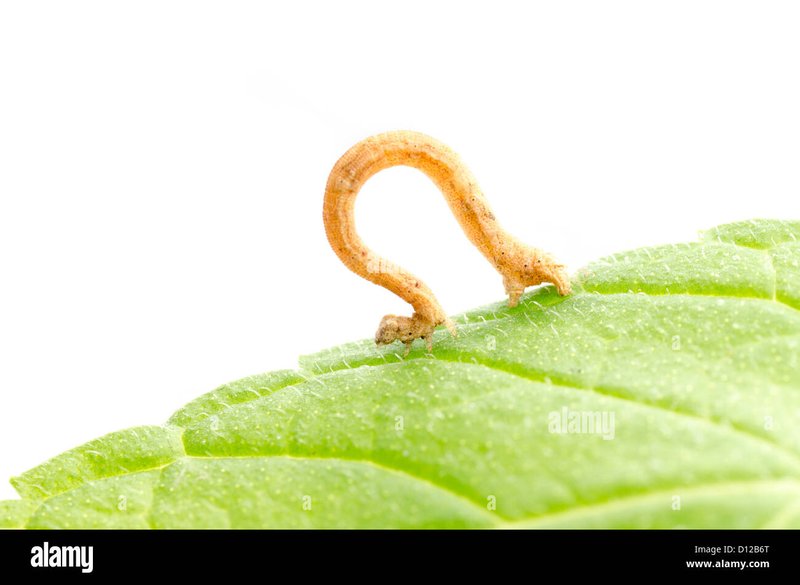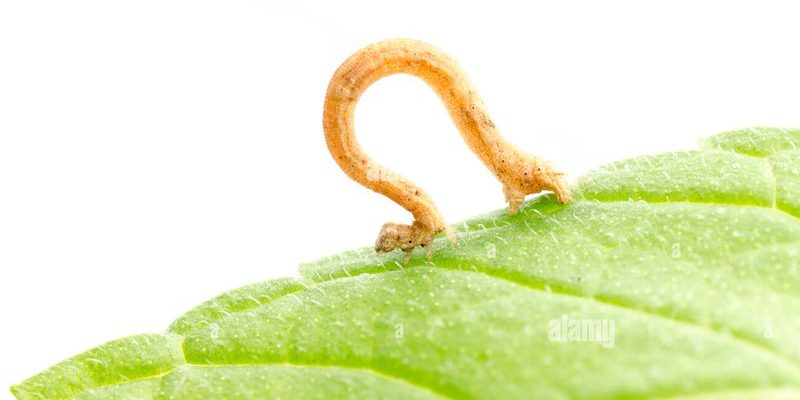
You might be wondering what makes these little guys so interesting. Are they pests? Or do they play a role in the ecosystem? And how can you tell them apart? Understanding the differences between inchworms and loopers isn’t just for the curious; it can help you in gardening, pest control, or even just enjoying nature during a hike.
What Are Inchworms?
Inchworms are the larvae of moths belonging to the Geometridae family, also known as geometrid moths. What’s really cool about them is how they move. Instead of just crawling like most caterpillars, inchworms “inch” forward in a unique way. They pull their hind end up, creating a loop, and then stretch out their front end—hence the name “inchworm.”
You’ll often find these little guys hanging around during spring and summer, munching on leaves from trees and shrubs. They can be green, brown, or even striped, which helps them blend into their surroundings. This camouflage is their best defense against predators, making them masters of hide-and-seek in the plant world.
Inchworms are mainly known for their distinctive movement, but they have an important role in nature. They serve as a food source for birds and other wildlife, helping to maintain a balanced ecosystem. So, while they might seem like a nuisance when they munch on your plants, they have their place in the grand scheme of things.
What Are Loopers?
Loopers, like inchworms, are also the larvae of moths, specifically within the Noctuidae family. But here’s where it gets interesting—loopers are technically a type of caterpillar that moves differently from their inchworm cousins. Instead of pulling themselves into a loop, loopers create a distinctive “looping” motion as they walk. They bring their hind end forward and then push their front end out, which appears as though they’re hopping or dancing.
Generally, loopers are more robust compared to inchworms, and they can come in a variety of colors. Some are even brightly colored, making them more eye-catching both to humans and predators. Just like inchworms, loopers are also quite hungry, feeding mostly on the leaves of vegetable crops, fruit plants, and ornamental plants.
Loopers can be a gardener’s nightmare since they can cause significant damage to your plants in a short time. However, knowing they exist is important because it can help you take preventive measures before they wreak havoc on your garden.
Physical Differences
At first glance, you might struggle to tell inchworms and loopers apart. Both are caterpillar-like in appearance and can be similar in color. But if you look closer, you’ll notice some distinct physical traits.
For starters, inchworms typically have a slender, elongated body. A defining feature is their less robust build, making them look almost delicate. In contrast, loopers tend to have a thicker and stouter appearance. It’s like comparing a slim athlete to a powerlifter—they both have their strengths, but their builds tell a different story.
Their movement also gives them away. Inchworms inch along, creating a distinctive “S” shape with their body. Meanwhile, loopers’ hopping movement is more pronounced, giving them an energetic, almost erratic look as they traverse leaves and branches.
Behavioral Differences
Understanding their behavior can also help distinguish between these two caterpillars. Inchworms tend to be more stealthy. They often remain motionless when disturbed, relying on their camouflage to avoid predators. This is especially true when they sense danger—they’ll freeze, looking just like a twig or leaf.
On the other hand, loopers are a bit more adventurous. They might move more frequently and show an alertness that inchworms don’t. If you watch a looper in action, you might notice it quickly attempts to escape by either hopping or weaving around obstacles. It’s as if the looper has a bit more confidence in its ability to evade danger.
Not to mention, when disturbed, loopers might even drop to the ground to avoid being eaten. This behavior can be likened to a child playing hide-and-seek—loopers are always looking for a good hiding spot!
Diet and Habitat
Both inchworms and loopers are herbivorous, meaning they primarily eat plants. However, their diet can vary somewhat based on their species. Inchworms tend to munch on the leaves of hardwood trees and shrubs, often preferring specific types of foliage. They like to blend into their surroundings, making them effective feeders.
Loopers, meanwhile, are often found in gardens and farms, where they can quickly decimate crops. They enjoy a wider range of plants, including many vegetables and flowers. This can make them a bigger pest for gardeners, as they can easily go from plant to plant, leaving a trail of devastation in their wake.
Regarding habitat, you’ll find both inchworms and loopers in similar environments, typically thriving in gardens, forests, and parks. However, their preferred microhabitats might differ slightly. Inchworms might settle on trees, while loopers can be found closer to ground level where they can access various plants for munching.
Why It Matters
Understanding the difference between inchworms and loopers is not just for fun—it can be really helpful, especially for those of us who enjoy gardening or simply want to appreciate nature more. Knowing what these caterpillars look like and how they behave can help you manage your garden more effectively.
If you notice some munching on your prized plants, it’s essential to identify whether you’re dealing with an inchworm or a looper. This knowledge allows you to choose the right approach for dealing with these critters. For example, certain pest control methods may work better for one than the other, so being informed can save you time, effort, and frustration.
Additionally, understanding these creatures encourages a better appreciation of our ecosystem. Every inchworm and looper plays a role, contributing to the balance of nature. Plus, they’re pretty fascinating little creatures when you think about their lives and habits!
In the grand tapestry of nature, inchworms and loopers are just two fascinating threads. While they may seem similar at first, the differences in their movement, behavior, diet, and physical traits reveal a world of wonder. Whether you’re a budding entomologist or just a curious gardener, recognizing these distinctions can enhance how you interact with nature.
So, the next time you spot one of these little crawlers in your yard, take a moment to appreciate their unique qualities. And remember, there’s always more to learn about the smallest creatures that inhabit our world. Whether it’s inchworms, loopers, or any other critter, each one has a story to tell!

